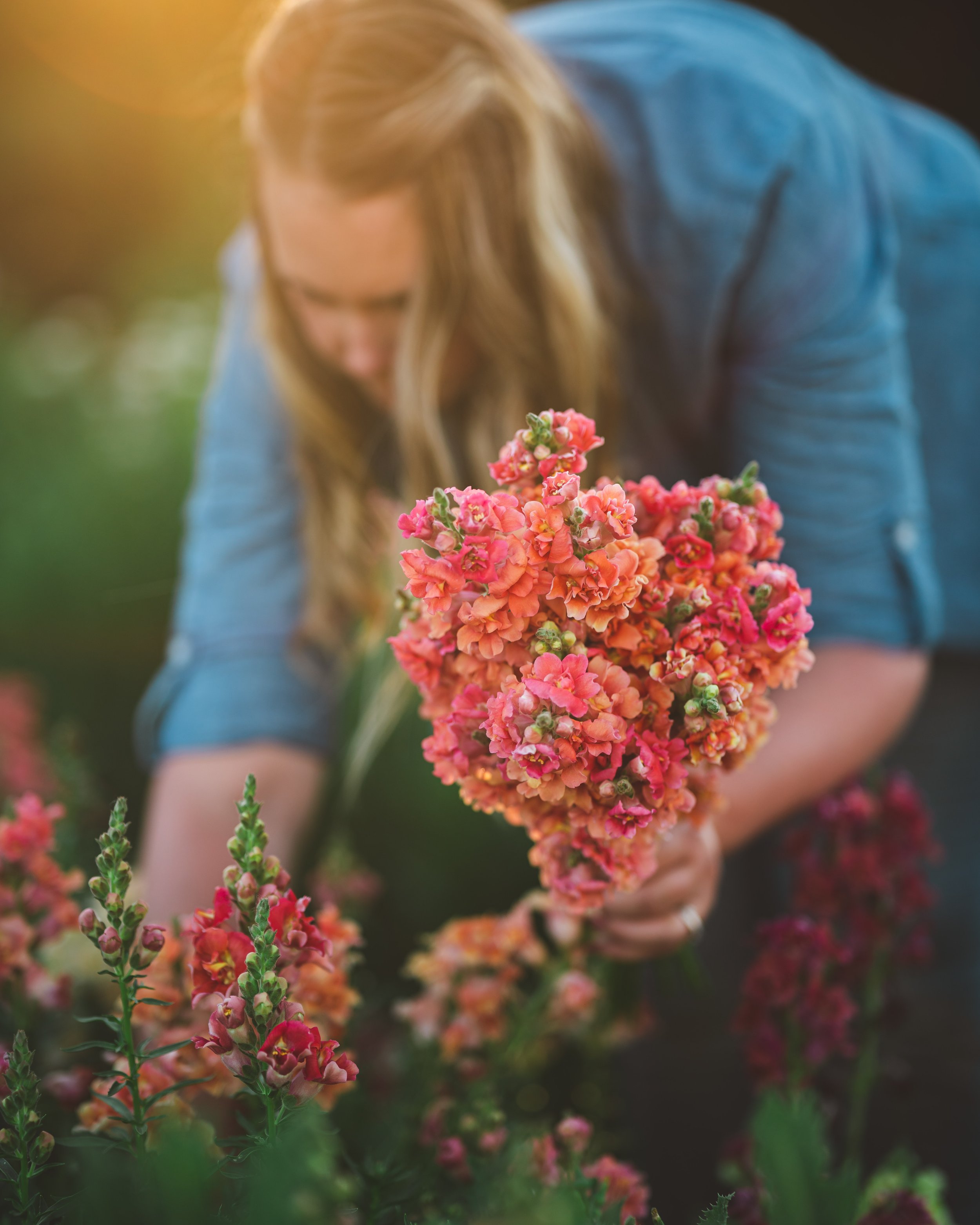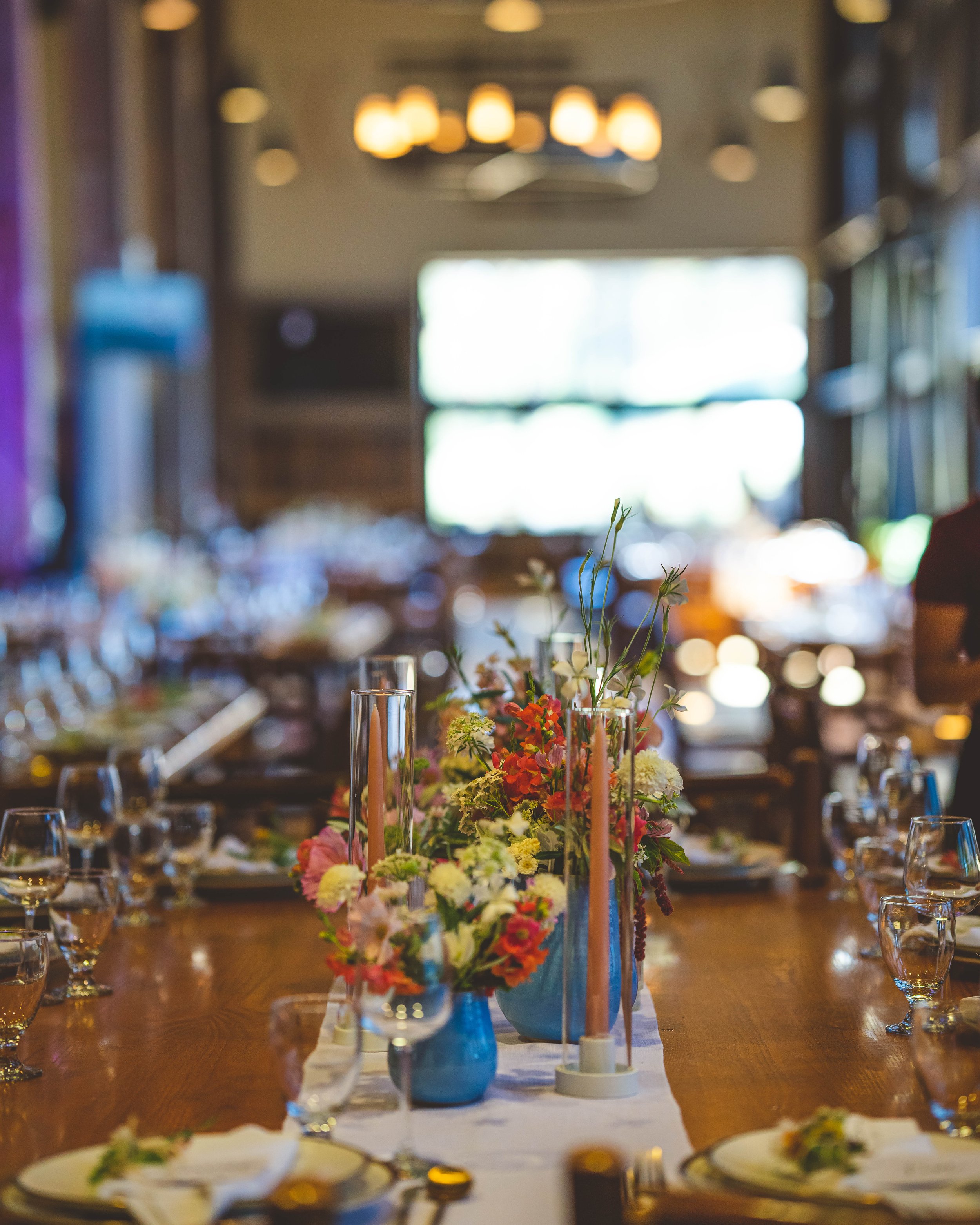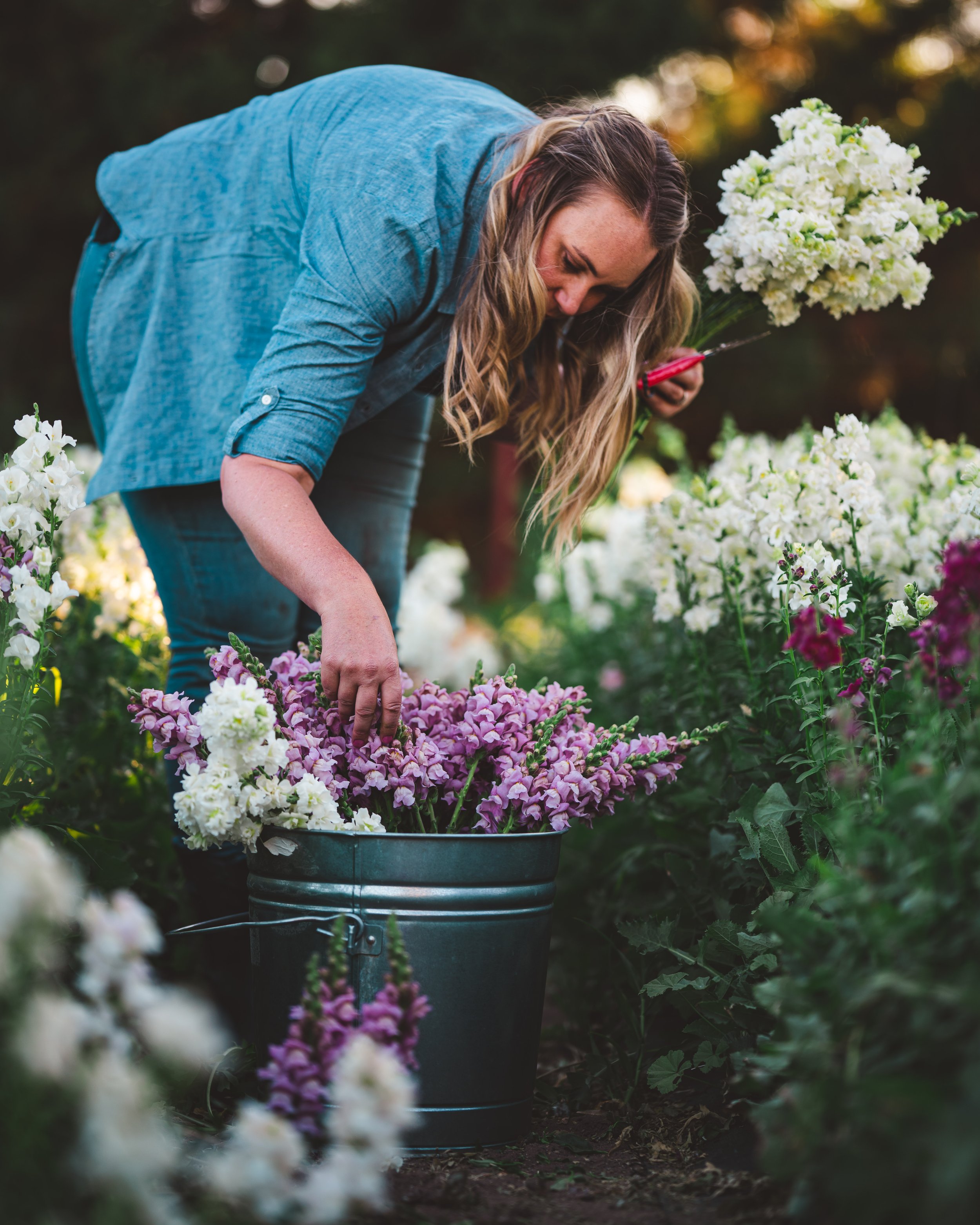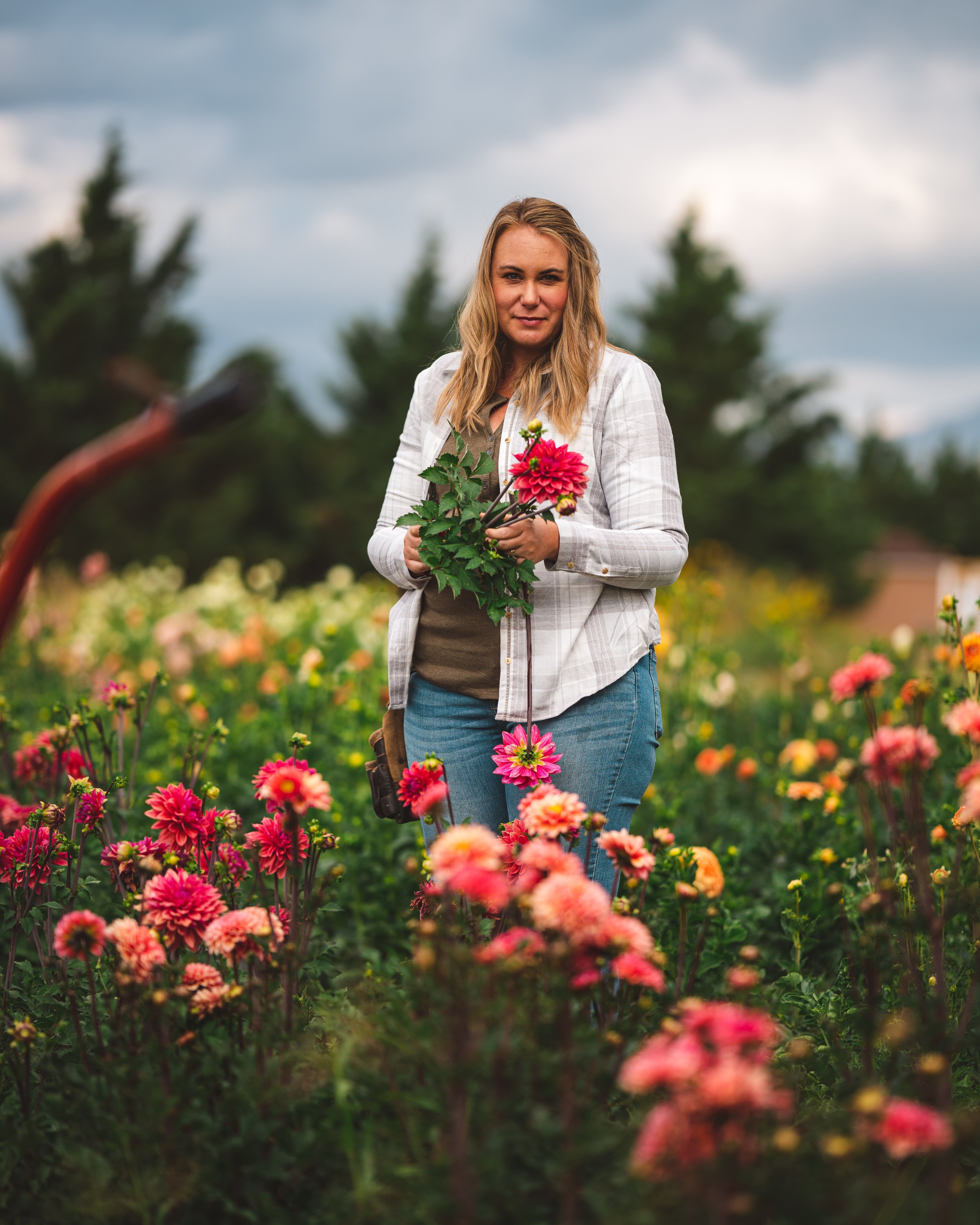Our Top 5 Picks From Our Flower Field
It is a running joke here that I can’t say no to a pretty flower.
I stand by it. I have indeed learned a lot about which varieties work and which don’t, which ones I love, and which ones give me horrible allergic reactions…
In recent years, however, I learned which varieties were more sought out by our wedding couples, florists, and customers. Our market is looking for a local flower farm that provides some pizazz or rare varieties only readily available from a local grower for their unusual beauty or quality.
There are different approaches a flower farmer can take to determine which crops to grow.
If you are looking to work only with the varieties you grow in the field, you will most likely have a smattering of crops to grow. If you sell wholesale, you will likely grow more volume of the requested varieties and less diversity. If you are growing for weddings, it will look different depending on whether you are looking only to use what comes from your field or if there are some crops you’re willing to purchase from another grower or wholesaler.
The tricky part comes when you need more space, time, and resources.
As much as we would love to grow every pretty flower, that will not make us profitable. As much as I may personally enjoy a particular crop or variety, it doesn’t mean it’ll necessarily sell or be good. It is a balancing act of selecting varieties worthy of space, resources, and dedication versus those that are not.
So which crops are worthy?
Let’s explore this further in today’s post.
Silver Years Dahlia
Which Flowers Are Worthy of Cut Flower Production?
The answer will be different for everyone.
Overall, the most successful crops we found to be worthy and keep adding more of are:
Unusual forms or colors
Best from a local grower
Suitable for each of our product and service offerings
Fairly simple. We can’t compete necessarily on volume, price, and sometimes “quality” that can be attained from a wholesaler. I say “quality” because I tend not to like how giant or “perfect” wholesaler flowers are.
However, we can compete by offering quality flowers that are fresh, not bruised in unusual colors and forms.
Today, we will share our top crops that we can’t have enough of on our small-scale flower farm!
Snapdragons
Snapdragons are commonly seen at wholesalers or nurseries but less frequently in mixed grocery store bouquets. Snapdragons tend to be familiar flowers, and customers love coming across the familiar just as much as unfamiliar flowers. Snapdragons are an essential crop for our cut flower farm; they are excellent as a filler and as a line or “spike” design component. Locally grown snapdragons are also incredibly special with their unique scent, often lost when not purchased from a local grower.
Unlike many other crops, snapdragons are inexpensive to grow and will reward you with blooms, especially in spring and fall.
Though we love the more traditional snapdragon forms, such as Potomac or rocket, we especially adore the more delicate-looking Chantilly snapdragons for our early-season crops and Madame Butterfly for summer and fall crops.
We grow the more traditional forms of snapdragons to put in mixed bouquet offerings or to use in some of our wedding work. Overall, though, for wedding work, to sell wholesale, or even place into mixed bouquets, the open-faced Chantilly and the azalea-type Madame Butterfly are where it’s at.
They are forms not typically seen at most traditional wholesales, giving them the mark of a local flower farmer.
Chantilly Snapdragons
Chantilly has a bit of a bad wrap. After all, their stems are not as long or as stout as those of the other types of snapdragons. Their delicate nature also makes them great for wedding work or to offer to an event florist. Their unusual shape is also appreciated more by the general public.
As growers, we especially appreciate Chantilly’s early bloom time. Even in our harsh climate, we can begin harvesting as early as May.
I can never get enough of light pink, bronze, and white. This year, I am also excited to try the light salmon from Johnny Seeds.
Personally, I prefer to leave out the highlighter yellow or red colors on this variety.
Madame Butterfly Snapdragons
I don’t see any reason for why not regarding Madame Butterfly.
They delicately smell like delicious bubblegum. They can be used in place of stock, which is great as a later-season offering or if the strong scent of stock is off-putting to your client base.
Not only does this variety fill up a mixed bouquet, but it is also great for installation designs, with its florets used in smaller designs, such as a flower crown or a dog floral collar.
The two colors we grow most are ivory and bronze. Growing a small amount of red can come in handy for those burgundy requests, and pink is also charming.
Traditional Formed Snapdragons
The more traditional form of snapdragons are workhorses in the flower patch. They pair wonderfully with the more novelty forms of Chantilly and Madame Butterfly but also tend to be more reliable.
The Costa, Potomac, and Rocket varieties are our favorite go-tos. The Costa and Potomac are great for spring and fall harvests, while the Rocket can hang in there during the summer months as long as you can combat all the caterpillars!
If you would like to learn more about growing snapdragons, you can read our blog here.
Zinnia patch
2. Zinnias
Growers have a love-hate relationship when it comes to zinnias.
In the past, they were considered a “cheap” flower. Zinnias can be pretty easy to grow, making them a popular flower to plant amongst a hobbyist gardener’s tomato plants. Zinnias also store poorly, so they must be sold relatively quickly once harvested. The latter reason also makes the local grower stand out when it comes to zinnias.
I dare say that zinnias are no longer just “cheap” flowers.
Florists in our area and wedding couples have inundated us with requests for zinnia flowers for their summer weddings. The florists and wedding couples don’t care much for the ease of growing the flowers; that is a task they do not have the luxury to take on! They also aren’t asking their local garden group, which has zinnias, especially for colors that create enchanting floral designs for events.
Thanks to the many small breeders, incredible colors and forms of zinnias are coming out that elevate this flower, promoting the local growers. It is time to embrace the flowers that large wholesalers cannot compete with us local growers—Zinnias store and ship poorly, catapulting them into the local flower farm’s wheelhouse of offerings.
Oklahoma Zinnias
We often use these adorable button zinnias in design work, and they are instrumental in bud vases.
The three most common colors we grow are ivory, salmon, and pink.
Benary Giant Zinnias
These are more giant flowered zinnias that can even compete with some dahlias!
The most requested color we grow in this series is the Salmon Rose, but there are plenty of other options!
Queen Lime Zinnias
These are more medium-sized flower heads in muted tones of mauve, peachy-orange, and lime greens. They can be significant in fall designs and used as a bridge color in event work. Otherwise, the colors can come across as muddy or dead in more casual offerings, which our customers don’t typically love.
Zinnia haageana
I love these little guys to be used as filler in mixed bouquets or arrangements. Aztec and Persian Carpet are the two main varieties we grow. The colors remind me slightly of the House of Gryffindor colors in Harry Potter, but other than that, they are lovely to have for fall.
Zinderella Zinnias
The lavender and peach colors sold me on the Zinderella zinnias; otherwise, getting the desirable form is hit or miss. This is why I’m incredibly excited for the next section…
Specialty Bred Zinnias
For the last couple of years, I have been obsessed with supporting and growing newly bred/work-in-progress varieties of zinnias from small growers. It is exciting to see such incredibly muted tones of these beloved flowers, which I truly feel will greatly benefit the local growers with their unique beauty!
Here are some growers working magic with zinnias; if you don’t already, be sure to follow them to stay up to date with their fundraisers and seed sales:
Kori is such a sweet person who took some lemons thrown her way and turned them into lemonade when she had to move her entire flower farm (along with shifting gears from focusing on growing cut flowers to breeding flowers) after experiencing some health difficulties. They are doing some fantastic things for the flower farming industry!
Most of us are familiar with Floret. They’ll launch their specialty zinnia seeds (including some from Dawn Creek) on February 6th, 2024, which I definitely have my reminder set for!
I may be biased here since Tiffany is a dear friend. She is doing exceptional work in the zinnia breeding world and is incredibly willing to share her knowledge. Her flowers are beautiful and happy, just like her! With a range of punchy salmons and muted blushes and icy pinks- I can spend hours in her zinnia patch looking at all the nuances of colors happening, and I have (which I will be sharing soon in an upcoming blog). Tiffany offers an annual seed fundraiser and will host a summer workshop on zinnia breeding!
As I write this, I am sure many more small-scale growers are working magic in breeding zinnias; these are just the ones I have personally supported.
The fantastic work of small-scale zinnia breeders gives us more hope and shows why we are embracing zinnias even more this upcoming season!
If you would like to learn how to grow zinnias, please be sure to read our blog on that here.
Fizzy White Cosmos
3. Cosmos
I adore cosmos!
Overall, they are happy flowers that are light and bouncy in bouquets and arrangements alike! Another flower that is relatively inexpensive to grow and are low maintenance.
From the very beginning of our flower farming journey, we grew cosmos. The summer before deciding to leap into flower farming, we went to the farmer’s market that, unknowingly, we would be selling cut flowers less than two years later.
We were on a tight budget, but they had a wonderful nosegay filled with pink and purple globe amaranth, lemon basil, and seashell cosmos. The simplicity of the flowers was beautiful, along with their unusual forms. Now, I will admit that after growing the seashell cosmos for one season and having them shatter prematurely on me, I fell more in love with some of the other varieties of cosmos.
Versailles Cosmos
This is an inexpensive variety of cosmos that I don’t grow as much for the flowers as I do for the greenery earlier in the season. Versailles is a lovely single-petaled variety that is also an incredibly inexpensive seed to purchase.
Double Click Cosmos
I love the fluffiness of the Double Click cosmos. The flower heads do tend to look down due to the weight of the flower heads, but this still lends an almost Victorian-era dose of elegance.
I mainly grow the white “Snow Puff,” but the cranberry is gorgeous for fall color palettes as well.
Cupcake Cosmos
One of my favorite novelty forms, where the flower looks like a cupcake liner!
We can’t get enough of the white and the blush colors, the bees also love to nestle into them at the end of the season.
Apricotta Cosmos
Apricotta is my new favorite! We tried growing Apricot Lemonade and though the color was pretty, I wasn’t super impressed with the quality of stems. Shh, don’t tell my oldest daughter- she just bought Apricot Lemonade seeds and is super excited about them. Apricotta, on the other hand, is prolific, and the color is gorgeous!
Never Enough White Cosmos
Since we not only do a lot of weddings but sell to florists, and let’s just be honest, white flowers brighten up any design, so we grow a majority of white cosmos. My two favorite go-to varieties in the last couple of years have been Psyche and Fizzy White.
Psyche is a heavy producer of stems on robust plants. Fizzy White is much the same but it also has a slightly tufted center that I have come to love.
Jilly Sweet Pea
4. Sweet Peas
Sweet peas are one of the flowers our customers have come to know us by. At the farmer’s market, we would have bunches of sweet peas that got scooped up by customers within the first hour. They are one of the most sentimental flowers to many customers we have sold to.
Sweet peas are another flower that doesn’t do well in storage and shipping. They become costly, plus much of their charm, like their scent, is lost. From a local grower, though, they can be enjoyed at their peak. Last year, our sweet pea patch trucked along all some, enough so we could tuck in sweet peas into bouquets and arrangements all season long! It was wonderful being able to spoil even our fall brides with some sweet peas.
Over the years, I had to come to terms with our harsh climate and lack of infrastructure (no high tunnels here!), which meant being more selective with sweet peas. Ultimately, we found the Spencer varieties to perform the best.
Some of our favorites include:
Mollie Rilstone
Jilly
Memorial Flight
Bristol
Windsor
White Frills
If you want to learn more about how to grow sweet peas, you can read our blog here.
Rock Run Ashley Dahlia
5. Dahlias
Last but not least are dahlias!
These are probably the most expensive upfront investments on our top five list, but they are more than worth it!
The good news is that it is easy to increase your dahlia stock by propagating cuttings from seed and dividing dahlia clumps into individual tubers.
Like the other crops listed in this post, dahlias are also the best sourced from a local grower. Even though a wholesaler may ship in dahlias, they don’t do great in the process. Dahlias bruise easily, plus, many of the wholesalers don’t over the newer or more beautiful varieties a local grower can offer.
Cafe Au Lait is our number one requested flower named by brides and florists alike. It is the one they know by name. Other than that, our second most requested flower is, well, dahlias. White dahlias, blush, cream, salmon, and bronze are heavily requested in our summer and fall months. I know I can’t ever have enough dahlias; I’m ecstatic that they are so well received!
Some of my favorite varieties (I’ll try to keep it on the shorter side) are:
Ryecroft Jann
Rock Run Ashley
Cafe Au Lait
Castle Drive
Honey Crichton
Bracken Sarah
Bracken Rose
Jowey Winnie
Linda’s Baby
Terracotta
L’ancresse
Sweet Nathalie
Okay, I have many more, but these are the varieties I find myself using more and more of.
To learn more about growing, lifting, dividing, and storing dahlias, read our blog on that topic here.
Buckets of Rose Toscano, Jowey Nicky, Rock Run Ashley
As much as I wish I could grow every pretty flower, it just doesn’t work. By giving more space and resources to the more sought-after varieties, I can continue to ensure the financial well-being of our cut flower farm. It wasn’t easy to come to terms with some varieties that I love but don’t necessarily sell as quickly, especially to florists. Some varieties are easier to get from a wholesaler. Instead of getting frustrated, we embraced the varieties that were unique to a local market.
Hopefully, our list helped you figure out which flowers are best for your local market and your flower farm's profitability.
We would love to know which varieties you have found to be successful with or are just looking forward to growing. Let us know in the comment section below!
Until next time, we are looking forward to helping you hand blooms soon!
- Jessica & Graham










